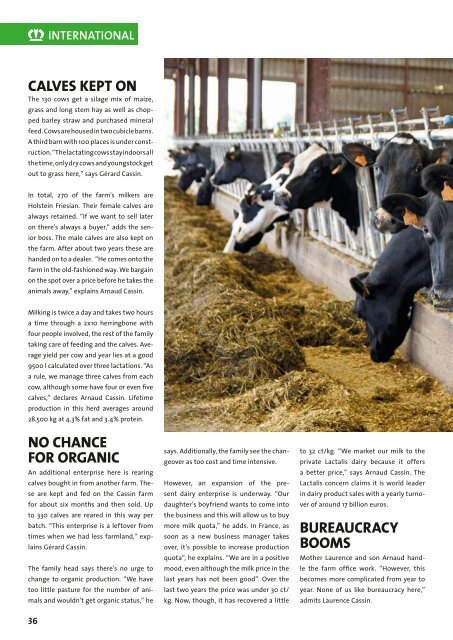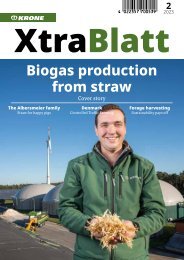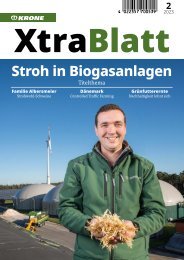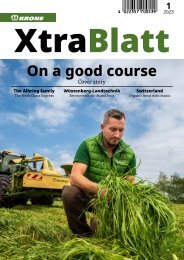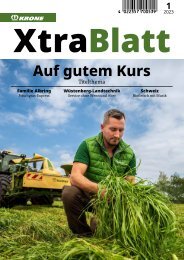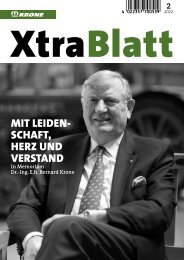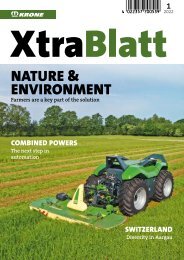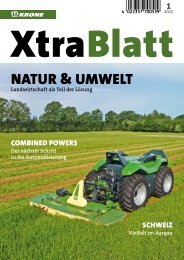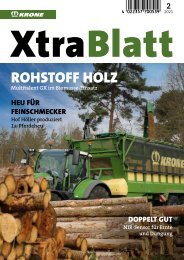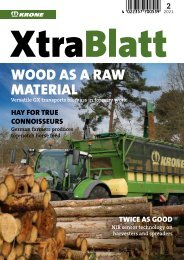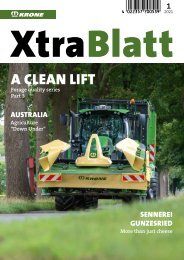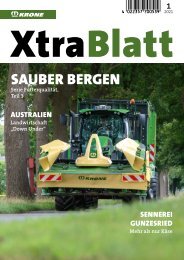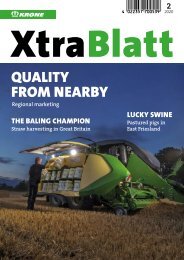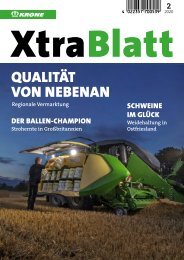XtraBlatt Issue 02-2017
Create successful ePaper yourself
Turn your PDF publications into a flip-book with our unique Google optimized e-Paper software.
MENSCHEN INTERNATIONAL<br />
CALVES KEPT ON<br />
The 130 cows get a silage mix of maize,<br />
grass and long stem hay as well as chopped<br />
barley straw and purchased mineral<br />
feed. Cows are housed in two cubicle barns.<br />
A third barn with 100 places is under construction.<br />
“The lactating cows stay indoors all<br />
the time, only dry cows and youngstock get<br />
out to grass here,” says Gérard Cassin.<br />
In total, 270 of the farm’s milkers are<br />
Holstein Friesian. Their female calves are<br />
always retained. “If we want to sell later<br />
on there’s always a buyer,” adds the senior<br />
boss. The male calves are also kept on<br />
the farm. After about two years these are<br />
handed on to a dealer. “He comes onto the<br />
farm in the old-fashioned way. We bargain<br />
on the spot over a price before he takes the<br />
animals away,” explains Arnaud Cassin.<br />
Milking is twice a day and takes two hours<br />
a time through a 2x10 herringbone with<br />
four people involved, the rest of the family<br />
taking care of feeding and the calves. Average<br />
yield per cow and year lies at a good<br />
9500 l calculated over three lactations. “As<br />
a rule, we manage three calves from each<br />
cow, although some have four or even five<br />
calves,” declares Arnaud Cassin. Lifetime<br />
production in this herd averages around<br />
28,500 kg at 4.3% fat and 3.4% protein.<br />
NO CHANCE<br />
FOR ORGANIC<br />
An additional enterprise here is rearing<br />
calves bought in from another farm. These<br />
are kept and fed on the Cassin farm<br />
for about six months and then sold. Up<br />
to 330 calves are reared in this way per<br />
batch. “This enterprise is a leftover from<br />
times when we had less farmland,” explains<br />
Gérard Cassin.<br />
The family head says there’s no urge to<br />
change to organic production. “We have<br />
too little pasture for the number of animals<br />
and wouldn’t get organic status,” he<br />
36<br />
says. Additionally, the family see the changeover<br />
as too cost and time intensive.<br />
However, an expansion of the present<br />
dairy enterprise is underway. “Our<br />
daughter’s boyfriend wants to come into<br />
the business and this will allow us to buy<br />
more milk quota,” he adds. In France, as<br />
soon as a new business manager takes<br />
over, it’s possible to increase production<br />
quota”, he explains. “We are in a positive<br />
mood, even although the milk price in the<br />
last years has not been good”. Over the<br />
last two years the price was under 30 ct/<br />
kg. Now, though, it has recovered a little<br />
to 32 ct/kg. “We market our milk to the<br />
private Lactalis dairy because it offers<br />
a better price,” says Arnaud Cassin. The<br />
Lactalis concern claims it is world leader<br />
in dairy product sales with a yearly turnover<br />
of around 17 billion euros.<br />
BUREAUCRACY<br />
BOOMS<br />
Mother Laurence and son Arnaud handle<br />
the farm office work. “However, this<br />
becomes more complicated from year to<br />
year. None of us like bureaucracy here,”<br />
admits Laurence Cassin.


